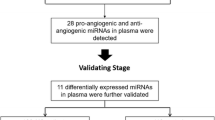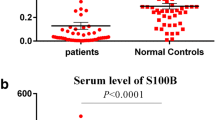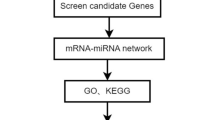Abstract
To investigate the correlations of five angiogenesis-related miRNA (miR-126, miR-130a, miR-222, miR-218, and miR-185) expression levels with risk, severity, and inflammatory cytokines levels in acute ischemic stroke (AIS) patients. A total of 148 AIS patients and 148 age- and gender-matched controls were consecutively enrolled. Blood samples were collected from AIS patients and controls, and plasma was separated for miRNAs and cytokine level detection. Plasma levels of miRNAs were evaluated by real-time qPCR method, and inflammatory cytokine levels were detected using an enzyme-linked immunosorbent assay (ELISA). Plasma miR-126 and miR-130a expression levels in AIS patients were lower than those of controls, while the levels of miR-222, miR-218, and miR-185 were elevated in AIS patients compared with controls. After pooling the five miRNA expression levels together, the area under the curve (AUC) for predicting AIS risk was 0.840 (95% CI 0.795–0.885) with a sensitivity of 83.8% and a specificity of 69.6% at the best cut-off point. Plasma miR-126 (r = − 0.402, P < 0.001) and miR-130a (r = − 0.161, P = 0.050) levels were negatively correlated with NIHSS scores, while plasma miR-218 level was positively correlated with NIHSS scores (r = 0.471, P < 0.001). Most importantly, plasma miR-126 expression was negatively correlated with TNF-α (r = − 0.168, P = 0.041), IL-1β (r = − 0.246, P = 0.003), and IL-6 (r = − 0.147, P = 0.035) levels, while miR-130a expression was negatively correlated with TNF-α (r = − 0.287, P < 0.001), IL-1β (r = − 0.168, P = 0.041), and IL-6 (r = − 0.239, P = 0.003) expression levels and positively associated with IL-10 level (r = 0.261, P = 0.001). Circulating miR-126 and miR-130a levels correlate with lower disease risk, decreased disease severity, and reduced inflammatory cytokine levels in AIS patients.




Similar content being viewed by others
References
Hankey GJ (2017) Stroke. Lancet 389(10069):641–654. https://doi.org/10.1016/S0140-6736(16)30962-X
Feigin VL, Forouzanfar MH, Krishnamurthi R, Mensah GA, Connor M, Bennett DA, Moran AE, Sacco RL, Anderson L, Truelsen T, O'Donnell M, Venketasubramanian N, Barker-Collo S, Lawes CM, Wang W, Shinohara Y, Witt E, Ezzati M, Naghavi M, Murray C, Global Burden of Diseases I, Risk Factors S, the GBDSEG (2014) Global and regional burden of stroke during 1990–2010: findings from the Global Burden of Disease Study 2010. Lancet 383(9913):245–254
Krishnamurthi RV, Feigin VL, Forouzanfar MH, Mensah GA, Connor M, Bennett DA, Moran AE, Sacco RL, Anderson LM, Truelsen T, O'Donnell M, Venketasubramanian N, Barker-Collo S, Lawes CM, Wang W, Shinohara Y, Witt E, Ezzati M, Naghavi M, Murray C, Global Burden of Diseases IRFS, Group GBDSE (2013) Global and regional burden of first-ever ischaemic and haemorrhagic stroke during 1990–2010: findings from the Global Burden of Disease Study 2010. Lancet Glob Health 1(5):e259–e281. https://doi.org/10.1016/S2214-109X(13)70089-5
Kilburg C, Scott McNally J, de Havenon A, Taussky P, Kalani MY, Park MS (2017) Advanced imaging in acute ischemic stroke. Neurosurg Focus 42(4):E10. https://doi.org/10.3171/2017.1.FOCUS16503
Sacco RL, Kasner SE, Broderick JP, Caplan LR, Connors JJ, Culebras A, Elkind MS, George MG, Hamdan AD, Higashida RT, Hoh BL, Janis LS, Kase CS, Kleindorfer DO, Lee JM, Moseley ME, Peterson ED, Turan TN, Valderrama AL, Vinters HV, American Heart Association Stroke Council CoCS, Anesthesia, Council on Cardiovascular R, Intervention, Council on C, Stroke N, Council on E, Prevention, Council on Peripheral Vascular D, Council on Nutrition PA, Metabolism (2013) An updated definition of stroke for the 21st century: a statement for healthcare professionals from the American Heart Association/American Stroke Association. Stroke 44(7):2064–2089. https://doi.org/10.1161/STR.0b013e318296aeca
Fisher M, Albers GW (2013) Advanced imaging to extend the therapeutic time window of acute ischemic stroke. Ann Neurol 73(1):4–9. https://doi.org/10.1002/ana.23744
Dong H, Lei J, Ding L, Wen Y, Ju H, Zhang X (2013) MicroRNA: function, detection, and bioanalysis. Chem Rev 113(8):6207–6233. https://doi.org/10.1021/cr300362f
Maitrias P, Metzinger-Le Meuth V, Nader J, Reix T, Caus T, Metzinger L (2017) The involvement of miRNA in carotid-related stroke. Arterioscler Thromb Vasc Biol 37(9):1608–1617. https://doi.org/10.1161/ATVBAHA.117.309233
Che F, Du H, Zhang W, Cheng Z, Tong Y (2018) MicroRNA-132 modifies angiogenesis in patients with ischemic cerebrovascular disease by suppressing the NFkappaB and VEGF pathway. Mol Med Rep 17(2):2724–2730. https://doi.org/10.3892/mmr.2017.8138
Majdi A, Mahmoudi J, Sadigh-Eteghad S, Farhoudi M, Shotorbani SS (2016) The interplay of microRNAs and post-ischemic glutamate excitotoxicity: an emergent research field in stroke medicine. Neurol Sci 37(11):1765–1771. https://doi.org/10.1007/s10072-016-2643-5
Zhou Y, Deng L, Zhao D, Chen L, Yao Z, Guo X, Liu X, Lv L, Leng B, Xu W, Qiao G, Shan H (2016) MicroRNA-503 promotes angiotensin II-induced cardiac fibrosis by targeting Apelin-13. J Cell Mol Med 20(3):495–505. https://doi.org/10.1111/jcmm.12754
Liang TY, Lou JY (2016) Increased expression of mir-34a-5p and Clinical Association in Acute Ischemic Stroke Patients and in a rat model. Med Sci Monit 22:2950–2955
Jin F, Xing J (2017) Circulating pro-angiogenic and anti-angiogenic microRNA expressions in patients with acute ischemic stroke and their association with disease severity. Neurol Sci 38(11):2015–2023. https://doi.org/10.1007/s10072-017-3071-x
van Solingen C, Seghers L, Bijkerk R, Duijs JM, Roeten MK, van Oeveren-Rietdijk AM, Baelde HJ, Monge M, Vos JB, de Boer HC, Quax PH, Rabelink TJ, van Zonneveld AJ (2009) Antagomir-mediated silencing of endothelial cell specific microRNA-126 impairs ischemia-induced angiogenesis. J Cell Mol Med 13(8A):1577–1585. https://doi.org/10.1111/j.1582-4934.2008.00613.x
Kong F, Zhou J, Zhou W, Guo Y, Li G, Yang L (2017) Protective role of microRNA-126 in intracerebral hemorrhage. Mol Med Rep 15(3):1419–1425. https://doi.org/10.3892/mmr.2017.6134
Chen Y, Gorski DH (2008) Regulation of angiogenesis through a microRNA (miR-130a) that down-regulates antiangiogenic homeobox genes GAX and HOXA5. Blood 111(3):1217–1226. https://doi.org/10.1182/blood-2007-07-104133
Poliseno L, Tuccoli A, Mariani L, Evangelista M, Citti L, Woods K, Mercatanti A, Hammond S, Rainaldi G (2006) MicroRNAs modulate the angiogenic properties of HUVECs. Blood 108(9):3068–3071. https://doi.org/10.1182/blood-2006-01-012369
Li Y, Song YH, Li F, Yang T, Lu YW, Geng YJ (2009) MicroRNA-221 regulates high glucose-induced endothelial dysfunction. Biochem Biophys Res Commun 381(1):81–83. https://doi.org/10.1016/j.bbrc.2009.02.013
Guan B, Wu K, Zeng J, Xu S, Mu L, Gao Y, Wang K, Ma Z, Tian J, Shi Q, Guo P, Wang X, He D, Du Y (2017) Tumor-suppressive microRNA-218 inhibits tumor angiogenesis via targeting the mTOR component RICTOR in prostate cancer. Oncotarget 8(5):8162–8172. https://doi.org/10.18632/oncotarget.14131
Han S, Kong YC, Sun B, Han QH, Chen Y, Wang YC (2016) microRNA-218 inhibits oxygen-induced retinal neovascularization via reducing the expression of roundabout 1. Chin Med J 129(6):709–715. https://doi.org/10.4103/0366-6999.178013
Hou J, Liu L, Zhu Q, Wu Y, Tian B, Cui L, Liu Y, Li X (2016) MicroRNA-185 inhibits angiogenesis in human microvascular endothelial cells through targeting stromal interaction molecule 1. Cell Biol Int 40(3):318–328. https://doi.org/10.1002/cbin.10572
Anrather J, Iadecola C (2016) Inflammation and stroke: an overview. Neurotherapeutics 13(4):661–670. https://doi.org/10.1007/s13311-016-0483-x
Esenwa CC, Elkind MS (2016) Inflammatory risk factors, biomarkers and associated therapy in ischaemic stroke. Nat Rev Neurol 12(10):594–604. https://doi.org/10.1038/nrneurol.2016.125
Khoshnam SE, Winlow W, Farzaneh M (2017) The interplay of MicroRNAs in the inflammatory mechanisms following ischemic stroke. J Neuropathol Exp Neurol 76(7):548–561. https://doi.org/10.1093/jnen/nlx036
Huang L, Ma Q, Li Y, Li B, Zhang L (2018) Inhibition of microRNA-210 suppresses pro-inflammatory response and reduces acute brain injury of ischemic stroke in mice. Exp Neurol 300:41–50. https://doi.org/10.1016/j.expneurol.2017.10.024
Yang HH, Chen Y, Gao CY, Cui ZT, Yao JM (2017) Protective effects of microRNA-126 on human cardiac microvascular endothelial cells against hypoxia/reoxygenation-induced injury and inflammatory response by activating PI3K/Akt/eNOS signaling pathway. Cell Physiol Biochem 42(2):506–518. https://doi.org/10.1159/000477597
Li ZC, Han N, Li X, Li G, Liu YZ, Sun GX, Wang Y, Chen GT, Li GF (2015) Decreased expression of microRNA-130a correlates with TNF-alpha in the development of osteoarthritis. Int J Clin Exp Pathol 8(3):2555–2564
Zheng H, Dong X, Liu N, Xia W, Zhou L, Chen X, Yang Z, Chen X (2016) Regulation and mechanism of mouse miR-130a/b in metabolism-related inflammation. Int J Biochem Cell Biol 74:72–83. https://doi.org/10.1016/j.biocel.2016.02.021
Author information
Authors and Affiliations
Corresponding author
Ethics declarations
Conflict of interest
The authors declare that they have no conflict of interest.
Ethical approval
All procedures performed in studies involving human participants were in accordance with the ethical standards of the research committee and with the 1964 Helsinki declaration and its later amendments or comparable ethical standards.
Informed consent
This study was approved by the Ethics Committee of Cangzhou Central Hospital, and all participants or direct family members signed the written informed consents.
Rights and permissions
About this article
Cite this article
Jin, F., Xing, J. Circulating miR-126 and miR-130a levels correlate with lower disease risk, disease severity, and reduced inflammatory cytokine levels in acute ischemic stroke patients. Neurol Sci 39, 1757–1765 (2018). https://doi.org/10.1007/s10072-018-3499-7
Received:
Accepted:
Published:
Issue Date:
DOI: https://doi.org/10.1007/s10072-018-3499-7




